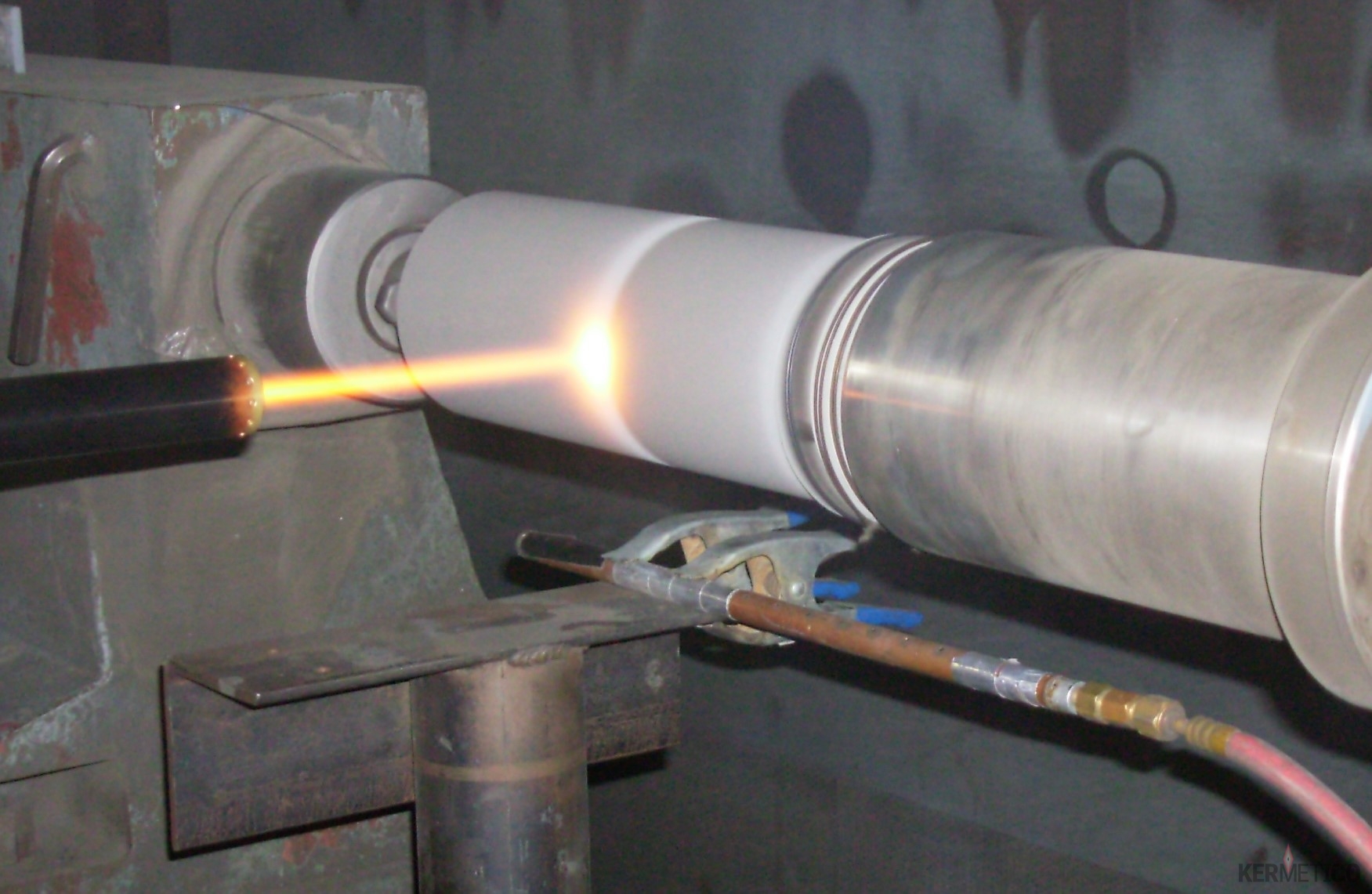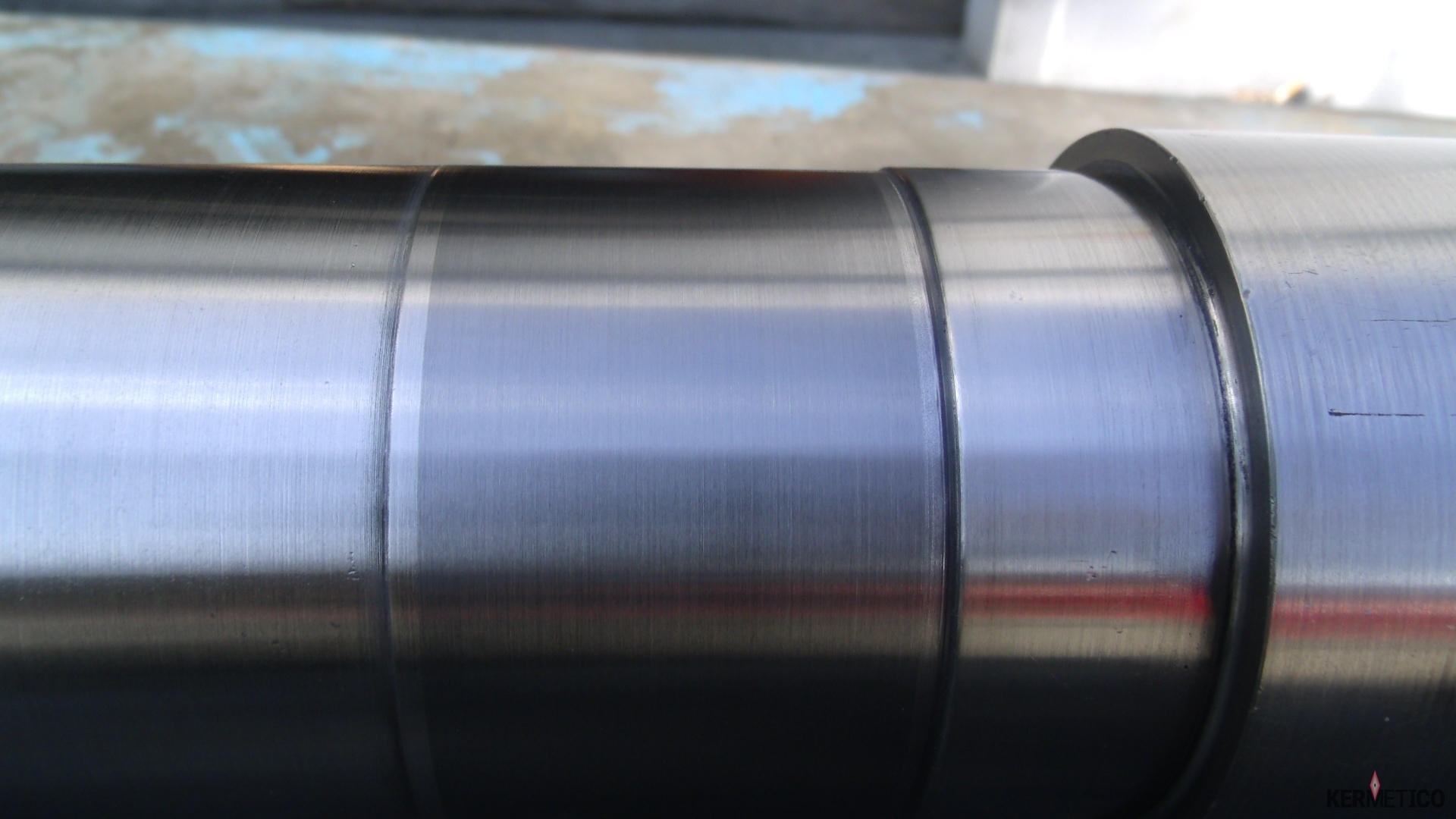Kermetico HVAF & HVOF technology and equipment allows the deposition of impermeable, hard and ductile wear resistant shaft coatings.
The high ductility of our metal ceramic shaft coatings reduces the risk of cracking if flexed and provides loading stress resistance while an optimal surface structure provides improved friction between a shaft and a bearing.
Compared to traditional electrolytic hard chromium plating, our shaft coatings are characterized by significantly higher wear resistance and the absence of hydrogen embrittlement of high-strength steels. They also have a better quality/price ratio than most other surface engineering methods.
Shaft Wear in Seals and Bearings
Wear of a Shaft Under a Seal
Radial shaft seals must run against a smooth, round shaft surface to seal efficiently. If the shaft becomes worn, the seals will no longer be able to fulfill their function, which is to retain lubricant and exclude contaminants.
Typically, the shaft becomes scored when a contaminant particle is caught under the sealing lip and abrades a track as the shaft rotates. As this continues, the seal will enable more particles to pass or get stuck, and seal efficiency deteriorates, eventually leading to malfunction of the component that the seal is meant to protect.
Shaft Wear in its Bearings
Under normal running conditions of full fluid lubrication wear of a shaft in its bearings is due primarily to the presence of grit, etc., which is imported into the bearing by the lubricating oil. Particles of grit, too small to be caught by any filter, become embedded in the surface of a bearing material but may still project sufficiently to span across the oil film when it is at its thinnest and so to lap the shaft. To a secondary degree it is due to attrition, when owing to the thinness of the oil film, the high spots on both members of the bearing come into metallic contact, but with highly finished surfaces, and an ample supply of lubricant, it is doubtful whether wear by attrition is an important factor provided that the materials are compatible and are not such as will readily weld together. Clearly, the higher the mean loading, the thinner the oil film will be on the loaded side of the bearing, and therefore the greater the intensity of the lapping process.
The harder the surface of the shaft or the softer the bearing material the particles will more readily be driven home into the latter and so out of harm’s way. Other things being equal, the rate of wear of the shaft will depend on the difference in surface hardness between itself and the material of the particles.
That is why different techniques of surface treatment are being used to protect a shaft surface.
The Features of Our HVAF Coating Technology
We recommend the application of Fe-based materials to protect shaft surfaces. Depending on the shaft base material, environment, sealing and bearing conditions we recommend using SS350, SS410, SS431 or harder 6AB coatings. For the most demanding applications, we use tungsten carbide coatings.
Just 100 µm of our coating is gas-tight, impermeable to gas or liquid without additional sealing.
Kermetico High Velocity Air Fuel (HVAF) technology has been shown to be very competitive as an environmentally friendly alternative to electrolytic hard chromium (EHC).
The ecological aspect and shorter processing time reduce processing costs.
The option to apply thicker layers provides a way to repair heavily worn components.
Kermetico HVAF metal and carbide coatings are also superior to conventional HVOF counterparts regarding wear resistance, corrosion protection and production cost. The higher velocity of the Kermetico HVAF in-flight particles (over 1,000 m/s) enables the production of coatings with high bond strength and low porosity.
Moreover, the low combustion spraying temperature (1,960-2,010 °C / 3,560-3650 °F) and gentle particle heating lead to minimal feedstock phase transformation and almost nonexistent elemental depletion/decomposition of the in-flight particles.
Furthermore, the replacement of pure oxygen necessary for HVOF with air in our HVAF process significantly reduces the oxide content of the coatings, which is desirable for high-performance coatings.
The result – gas-tight metal or carbide coatings, impermeable to gas or liquid.
The Kermetico HVAF Shaft Coating Method
The traditional thermal spray coating approach is to melt and atomize the feedstock, propel it to the surface of the target part whereupon contact ‘splat cooling’ builds up a coating.
The Kermetico HVAF process operates on a different principle “heat slowly, spray faster.“
We heat the feedstock material to near its liquid phase temperature without exceeding it.
Then we accelerate the particles to an optimized high velocity, and when the particles impact the substrate, there is a rapid conversion of kinetic to thermal energy that allows for plastic deformation of the particle and a bond that we cannot accurately measure.
In the ASTM 633C bond test, the only result we get is broken glue, even with 0.040“ (1 mm) of the WC-based coating.
A Polished Shaft with a Kermetico HVAF Steel Coating
Blasting and Spraying Shafts with Kermetico High Velocity Equipment
Usually, we deposit coatings using robotic blast and spray operations.
We blast a shaft surface with a Kermetico HVAF gun (it is extremely fast and uniform) and spray with the same gun after switching the powder feed hose and perhaps changing the nozzle.
It is much faster, more accurate and needs much less grit than manual blasting.
HVAF grit blasting also produces very even surface preparation and induces less stress into the base metal of a shaft.
Kermetico HVAF & HVOF Thermal Spray Coating Equipment
Kermetico designs and manufactures HVAF and HVOF thermal spray coating equipment.
- Convertible HVOF and HVAF equipment:
- Multi-purpose HVAF AK systems, with a range of spray guns:
- AK7 – a high-power gun for the thermal spray of large parts – recommended for large shafts
- AK6 – a universal gun to spray a balanced mix of parts in a job shop – recommended for medium shafts
- AK5 – a compact gun to spray smaller parts, thin walls and complex surfaces – recommended for small shafts
- AK-ID – an 80 mm (3.15”) and larger internal diameter spray gun
- AK-IDR – a rotating ID gun to spray 4” (100 mm) and larger bores
- AK-HH – a handheld gun for on-site coating
- Additional equipment:
- An HVAF grit feeder for the grit blast preparation of parts to reduce coating costs
- A Gas Permeability Tester for an instant check of a coating’s through porosity
Kermetico, Inc. – HVAF Material Science Excellence, Equipment Manufacturing and Thermal Spray Coating Since 2006
We create equipment that helps material scientists, engineers, and business managers achieve their goals.
We have installed more than 60 Kermetico HVAF systems in the USA, Europe, Japan and China.
Some of the systems are at work in Universities and National Labs, but most of them are used in production thermal spray shops.
We proudly design and produce our HVAF thermal spray equipment in California and install it all over the world.
You can visit our R&D center in Benicia to meet our designers and see our HVAF and HVOF equipment in action.
We also apply HVAF and HVOF thermal spray coatings for customers in North America – ourselves and through our network of partners.





















